Effect of Laser Remelting on Friction-Wear Behaviors of Cold Sprayed Al Coatings in 3.5% NaCl Solution
Abstract
:1. Introduction
2. Experimental
3. Analysis and Discussion of Results
3.1. Characterization of Al Coatings
3.1.1. Morphologies of Al Coating Surfaces and Cross Sections
3.1.2. XRD Analysis
3.1.3. Hardness Analysis
3.2. COFs and Wear Profiles
3.2.1. Effect of Load on Friction-Wear
3.2.2. Effect of Wear Speed on Friction-Wear
3.3. Plane Scanning Analysis of Worn Tracks
3.4. Wear Mechanism
4. Conclusions
- (1)
- The average hardness of cold sprayed Al coating was 49.96 HV, while that after LR was 104.66 HV, increasing by 109.5% compared to that before LR.
- (2)
- The average COFs of cold sprayed Al coatings at the wear loads of 1, 3 and 5 N were 0.285, 0.239, and 0.435, respectively, and the corresponding wear rates were 1.60 × 10−4, 2.36 × 10−4 and 2.40 × 10−4 mm3/m·N, respectively; while those after LR were 0.243, 0.227, and 0.327, respectively, and the corresponding wear rates are 1.59 × 10−4, 1.70 × 10−4 and 1.94 × 10−4 mm3/m·N, respectively, showing that the friction-wear properties of Al coatings are improved after LR.
- (3)
- The average COFs of Al coatings at the wear speeds of 300, 400 and 500 times/min (wear load of 1.0 N) were 0.294, 0.279, and 0.239, respectively, and the corresponding wear rates were 1.06 × 10−4, 1.24 × 10−4, and 1.70 × 10−4 mm3/m·N, showing the lower COFs and wear rates.
- (4)
- The wear mechanism of cold sprayed Al coating in 3.5% NaCl solution is corrosion wear under 0.5 and 1.0 N load, which is abrasive wear + fatigue wear under 1.5 N; while that after LR that is abrasive wear + fatigue wear, with no corrosion wear, showing that LR reduces the porosity of Al coating and improve its corrosion wear resistance.
Acknowledgments
Author Contributions
Conflicts of Interest
References
- Ribeiro, J.; Santiago, A.; Rigueiro, C. Damage model calibration and application for S355 steel. Procedia Struct. Integr. 2016, 2, 656–663. [Google Scholar] [CrossRef]
- Gao, W.; Wang, D.; Cheng, F.; Di, X.; Deng, C. Microstructural and mechanical performance of underwater wet welded S355 steel. J. Mater. Process. Technol. 2016, 238, 333–340. [Google Scholar] [CrossRef]
- Zhong, L.; Wang, Z.Y.; Zhang, H.D. Research progress of precipitation mechanism and apparatus of cold spray. Surf. Technol. 2015, 44, 15–22. [Google Scholar]
- Dykhuizen, R.C.; Smith, M.F.; Gilmore, D.L.; Neiser, R.A.; Jiang, X. Impact of high velocity cold spray particles. J. Therm. Spray Technol. 1999, 8, 559–564. [Google Scholar] [CrossRef]
- Steenkiste, T.H.V.; Smith, J.R.; Teets, R.E. Aluminum coatings via kinetic spray with relatively large powder particles. Surf. Coat. Technol. 2002, 1154, 237–252. [Google Scholar] [CrossRef]
- Assadi, H.; Gärtner, F.; Stoltenhoff, T.; Kreye, H. Bonding mechanism in cold gas spraying. Acta Mater. 2003, 51, 4379–4394. [Google Scholar] [CrossRef]
- Schmidt, T.; Gärtner, F.; Assadi, H.; Kreye, H. Development of a generalized parameter window for cold spray deposition. Acta Mater. 2006, 54, 729–742. [Google Scholar] [CrossRef]
- Gärtner, F.; Schmidt, T.; Stoltenhoff, T.; Kreye, H. Recent developments and potential applications of cold spraying. Adv. Eng. Mater. 2010, 8, 611–618. [Google Scholar] [CrossRef]
- Spencer, K.; Luzin, V.; Matthews, N.; Zhang, M.X. Residual stresses in cold spray Al coatings: The effect of alloying and of process parameters. Surf. Coat. Technol. 2012, 206, 4249–4255. [Google Scholar] [CrossRef]
- Chen, D.; Li, Z.S.; Wu, H.L.; Cong, D.L. Study on corrosion resistance of cold sprayed pure aluminum coating. Surf. Technol. 2016, 45, 174–179. [Google Scholar]
- Qian, M.; Li, D.; Liu, S.B.; Gong, S.L. Corrosion performance of laser–remelted Al–Si coating on magnesium alloy AZ91D. Corros. Sci. 2010, 52, 3554–3560. [Google Scholar] [CrossRef]
- Wang, Y.; Li, C.; Guo, L.; Tian, W. Laser remelting of plasma sprayed nanostructured Al2O3–TiO2, coatings at different laser power. Surf. Coat. Technol. 2010, 204, 3559–3566. [Google Scholar] [CrossRef]
- Poza, P.; Múnez, C.J.; Garrido-Maneiro, M.A.; Vezzù, S.; Rech, S. Mechanical properties of Inconel 625 cold–sprayed coatings after laser remelting. Depth sensing indentation analysis. Surf. Coat. Technol. 2014, 243, 1–57. [Google Scholar] [CrossRef]
- Wang, L.; Wang, N.; Yao, W.J.; Zheng, Y.P. Effect of substrate orientation on the columnar-to-equiaxed transition in laser surface remelted single crystal superalloys. Acta Mater. 2015, 88, 283–292. [Google Scholar] [CrossRef]
- Wang, Y.; Li, C.G.; Tian, W.; Yang, Y. Laser surface remelting of plasma sprayed nanostructured Al2O3–13 wt % TiO2 coatings on titanium alloy. Appl. Surf. Sci. 2009, 255, 8603–8610. [Google Scholar] [CrossRef]
- Riveiro, A.; Mejías, A.; Lusquiños, F.; Val, J.D.; Comesaña, R.; Pardo, J.; Pou, J. Optimization of laser cladding for Al coating production. Phys. Procedia 2013, 41, 327–334. [Google Scholar] [CrossRef]
- Yao, J.; Yang, L.; Li, B.; Li, Z. Beneficial effects of laser irradiation on the deposition process of diamond/Ni60 composite coating with cold spray. Appl. Surf. Sci. 2015, 330, 300–308. [Google Scholar] [CrossRef]
- Almangour, B.; Grzesiak, D.; Yang, J.M. Scanning strategies for texture and anisotropy tailoring during selective laser melting of TiC/316L stainless steel nanocomposites. J. Alloys Compd. 2017, 728, 424–435. [Google Scholar] [CrossRef]
- Almangour, B.; Grzesiak, D.; Jenn-MingYang. Selective laser melting of TiC reinforced 316L stainless steel matrix nanocomposites: Influence of starting TiC particle size and volume content. Mater. Des. 2016, 104, 141–151. [Google Scholar] [CrossRef]
- Sun, Z.; Zhang, D.H.; Yan, B.X.; Kong, D.J. Effects of laser remelting on microstructures and immersion corrosion performance of arc sprayed Al coating in 3.5% NaCl solution. Opt. Laser Technol. 2018, 99, 282–290. [Google Scholar] [CrossRef]
- Li, B.; Jin, Y.; Yao, J.; Zhang, Q. Influence of laser irradiation on deposition characteristics of cold sprayed Stellite—6 coatings. Opt. Laser Technol. 2018, 100, 27–39. [Google Scholar] [CrossRef]
- Kang, N.; Verdy, C.; Coddet, P.; Xie, Y.C.; Fu, Y.Q.; Liao, H.L.; Coddet, C. Effects of laser remelting process on the microstructure, roughness and microhardness of in-situ cold sprayed hypoeutectic Al–Si coating. Surf. Coat. Technol. 2017, 318, 355–359. [Google Scholar] [CrossRef]
- Podrabinnik, P.; Grigoriev, S.; Shishkovsky, I. Laser post annealing of cold-sprayed Al/alumina–Ni composite coatings. Surf. Coat. Technol. 2015, 271, 265–268. [Google Scholar] [CrossRef]
- Srinivasa, R.B.; Wang, D.; Price, T.; Zhang, D.; Keshri, A.K.; Chen, Y.; McCartney, D.G.; Shipway, P.H.; Agarwal, A. Microstructure and wear properties of aluminum/aluminum–silicon composite coatings prepared by cold spraying. Surf. Coat. Technol. 2009, 204, 503–510. [Google Scholar]
- Anandkumar, R.; Almeida, A.; Vilar, R. Microstructure and sliding wear resistance of an Al–12 wt % Si/TiC laser clad coating. Wear 2012, 282–283, 31–39. [Google Scholar] [CrossRef]
- Pitchuk, S.B.; Boesl, B.; Zhang, C.; Lahiri, D.; Nieto, A.; Sundararajan, G.; Agarwal, A. Dry sliding wear behavior of cold sprayed aluminum amorphous/nanocrystalline alloy coatings. Surf. Coat. Technol. 2014, 238, 118–125. [Google Scholar] [CrossRef]
- Shockley, J.M.; Descartes, S.; Vo, P.; Irissou, E.; Chromik, R.R. The influence of Al2O3 particle morphology on the coating formation and dry sliding wear behavior of cold sprayed Al–Al2O3 composites. Surf. Coat. Technol. 2015, 270, 324–333. [Google Scholar] [CrossRef]
- Gao, M.H.; Lu, W.Y.; Yang, B.J.; Zhang, S.D.; Wang, J.Q. High corrosion and wear resistance of Al–based amorphous metallic coating synthesized by HVAF spraying. J. Alloys Compd. 2018, 735, 1363–1373. [Google Scholar] [CrossRef]
- Ramesh, C.S.; Ahamed, A. Friction and wear behaviour of cast Al 6063 based in situ metal matrix composites. Wear 2011, 271, 1928–1939. [Google Scholar] [CrossRef]
- Bai, X.M.; Tang, J.Q.; Gong, J.M.; Lü, X.L. Corrosion performance of Al–Al2O3 cold sprayed coatings on mild carbon steel pipe under thermal insulation. Chin. J. Chem. Eng. 2017, 25, 533–539. [Google Scholar] [CrossRef]
- Nejadseyfi, O.; Shokuhfar, A.; Dabiri, A.; Azimi, A. Combining equal-channel angular pressing and heat treatment to obtain enhanced corrosion resistance in 6061 aluminum alloy. J. Alloys Compd. 2015, 648, 912–918. [Google Scholar] [CrossRef]
- Allachi, H.; Chaouket, F.; Draoui, K. Protection against corrosion in marine environments of AA6060 aluminium alloy by cerium chlorides. J. Alloys Compd. 2010, 491, 223–229. [Google Scholar] [CrossRef]
- Khruschov, M.M. Principles of abrasive wear. Wear 1974, 28, 69–88. [Google Scholar] [CrossRef]
- Wu, G.; Dai, W.; Zheng, H.; Wang, A. Improving wear resistance and corrosion resistance of AZ31 magnesium alloy by DLC/AlN/Al coating. Surf. Coat. Technol. 2010, 205, 2067–2073. [Google Scholar] [CrossRef]
- Yonekura, D.; Fujita, J.; Miki, K. Fatigue and wear properties of Ti–6Al–4V alloy with Cr/CrN multilayer coating. Surf. Coat. Technol. 2015, 275, 232–238. [Google Scholar] [CrossRef]
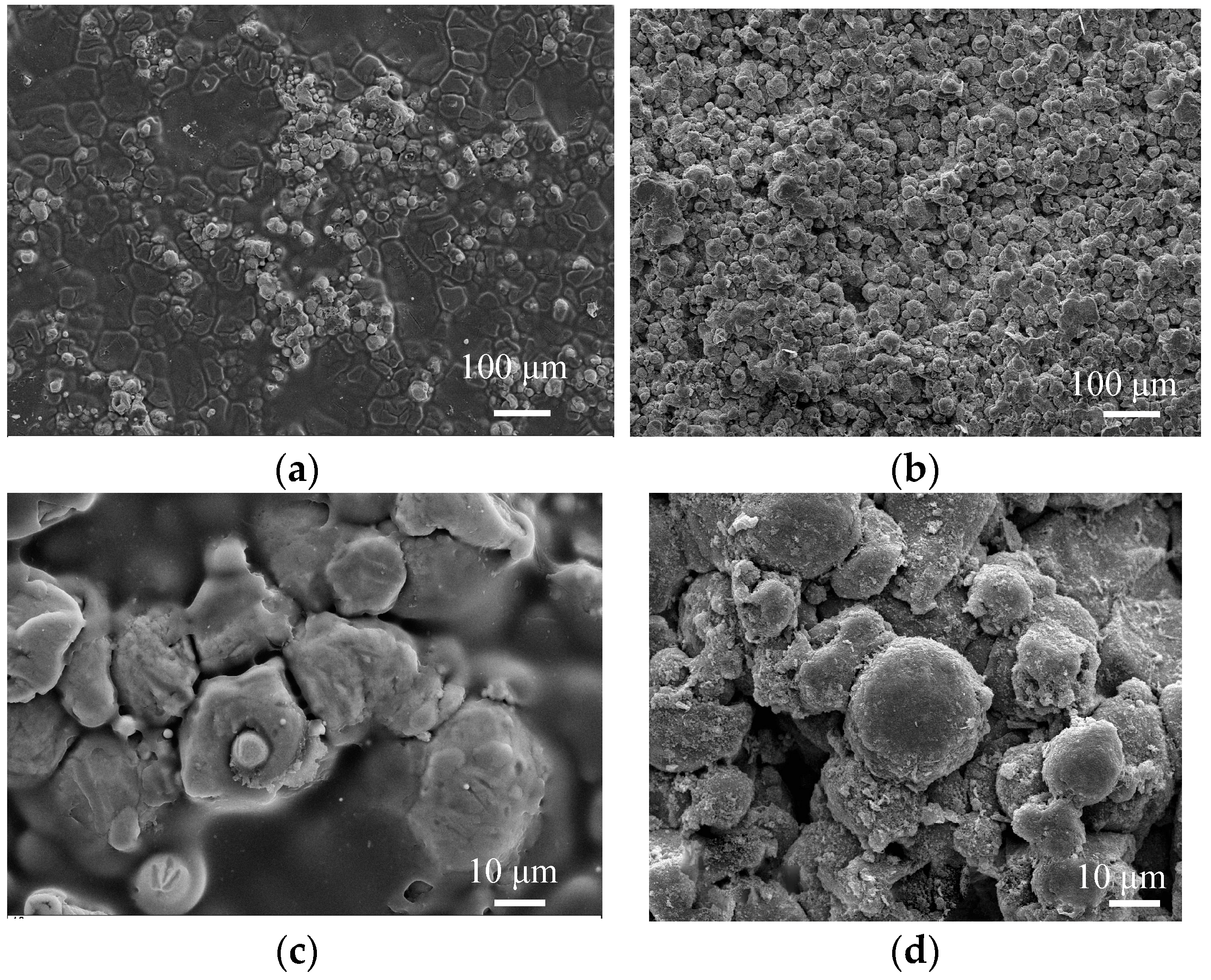
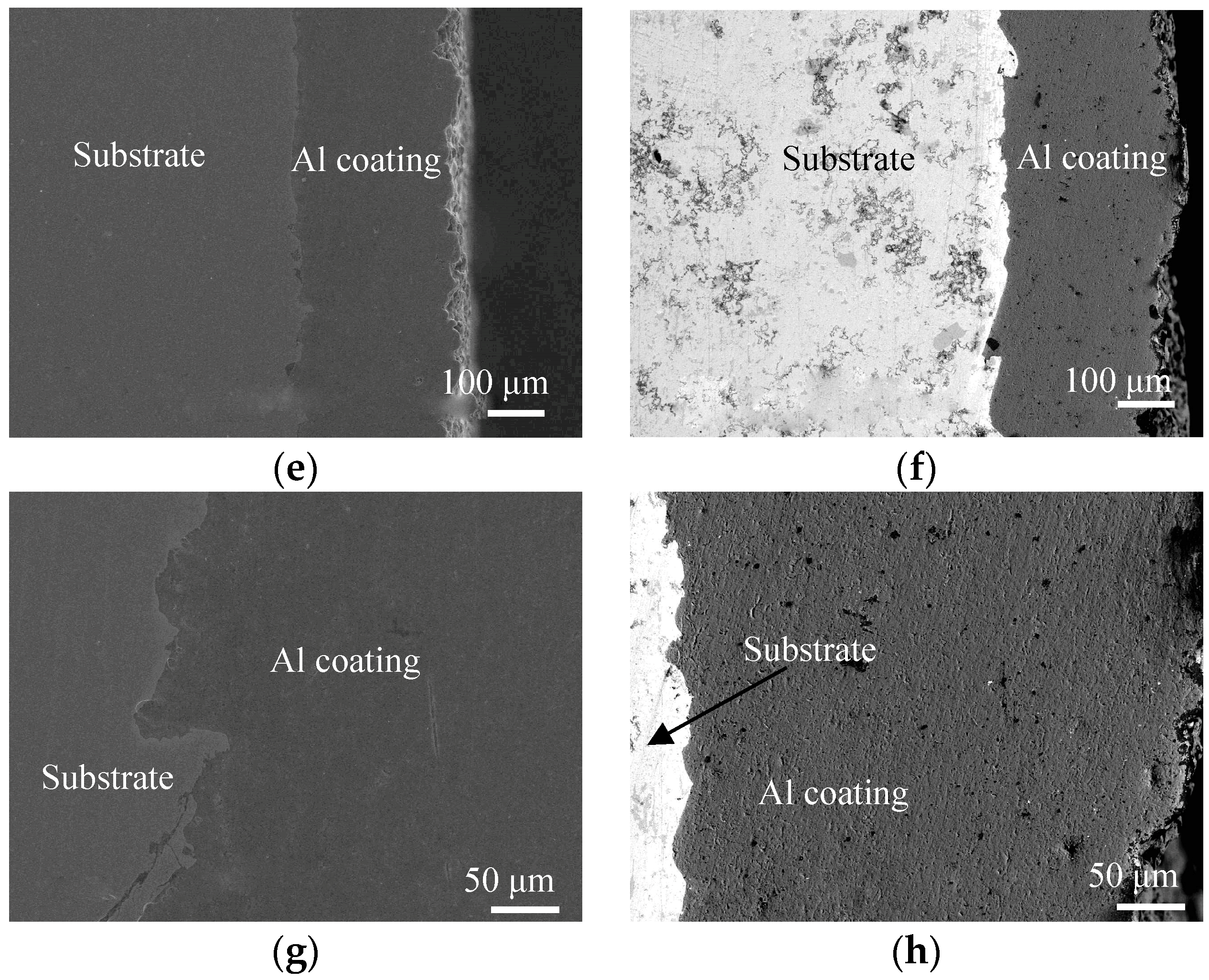
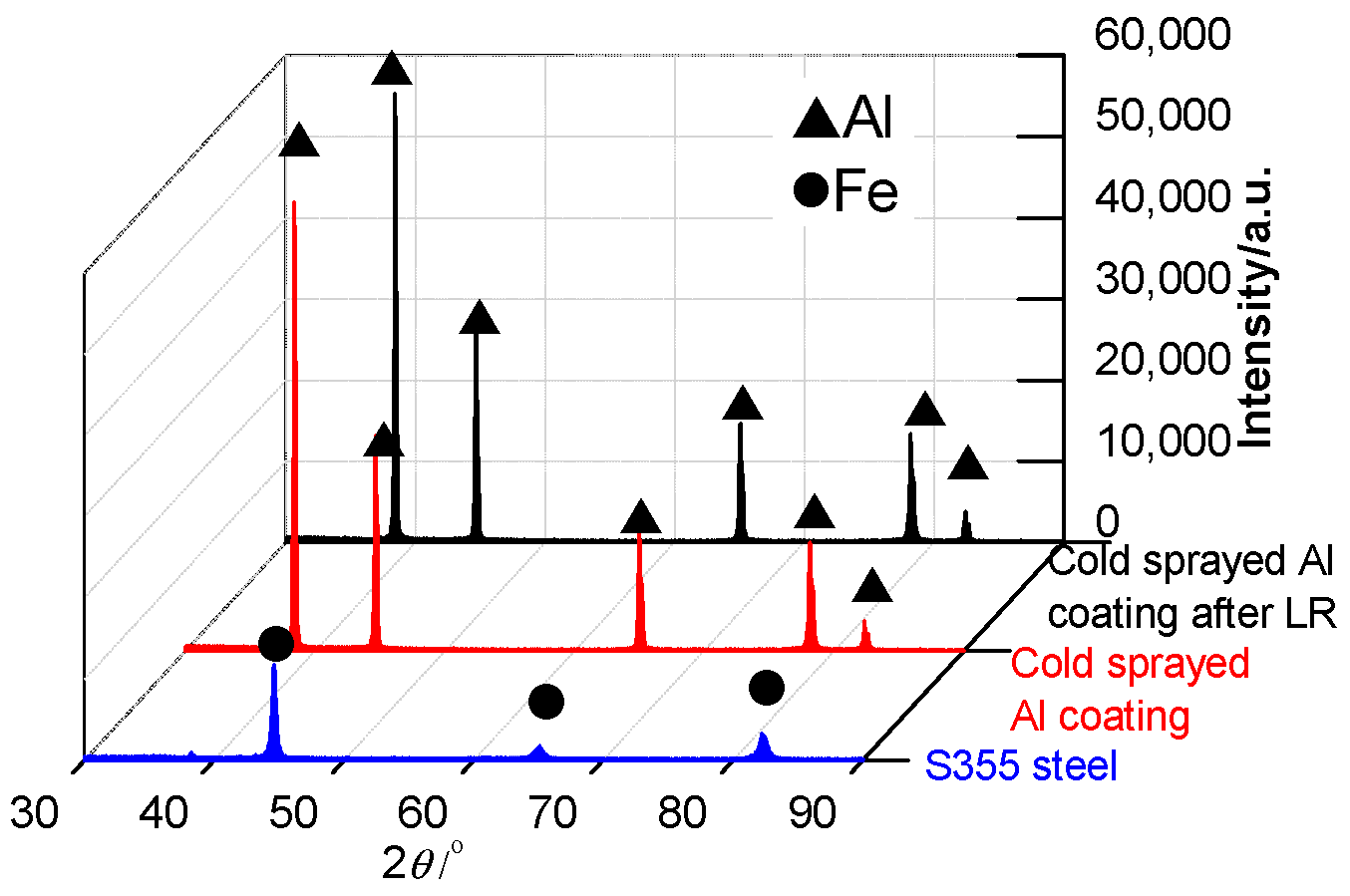



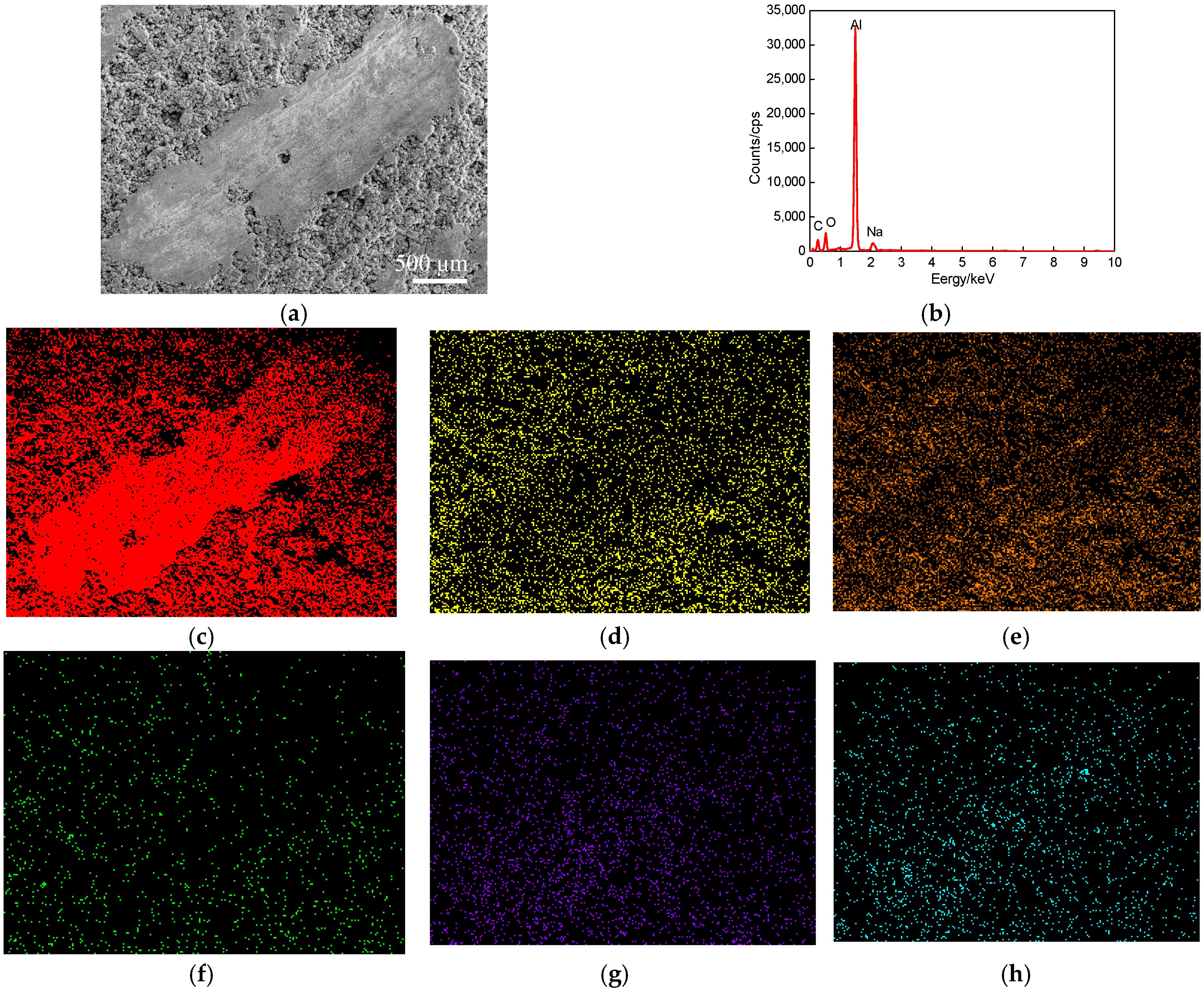
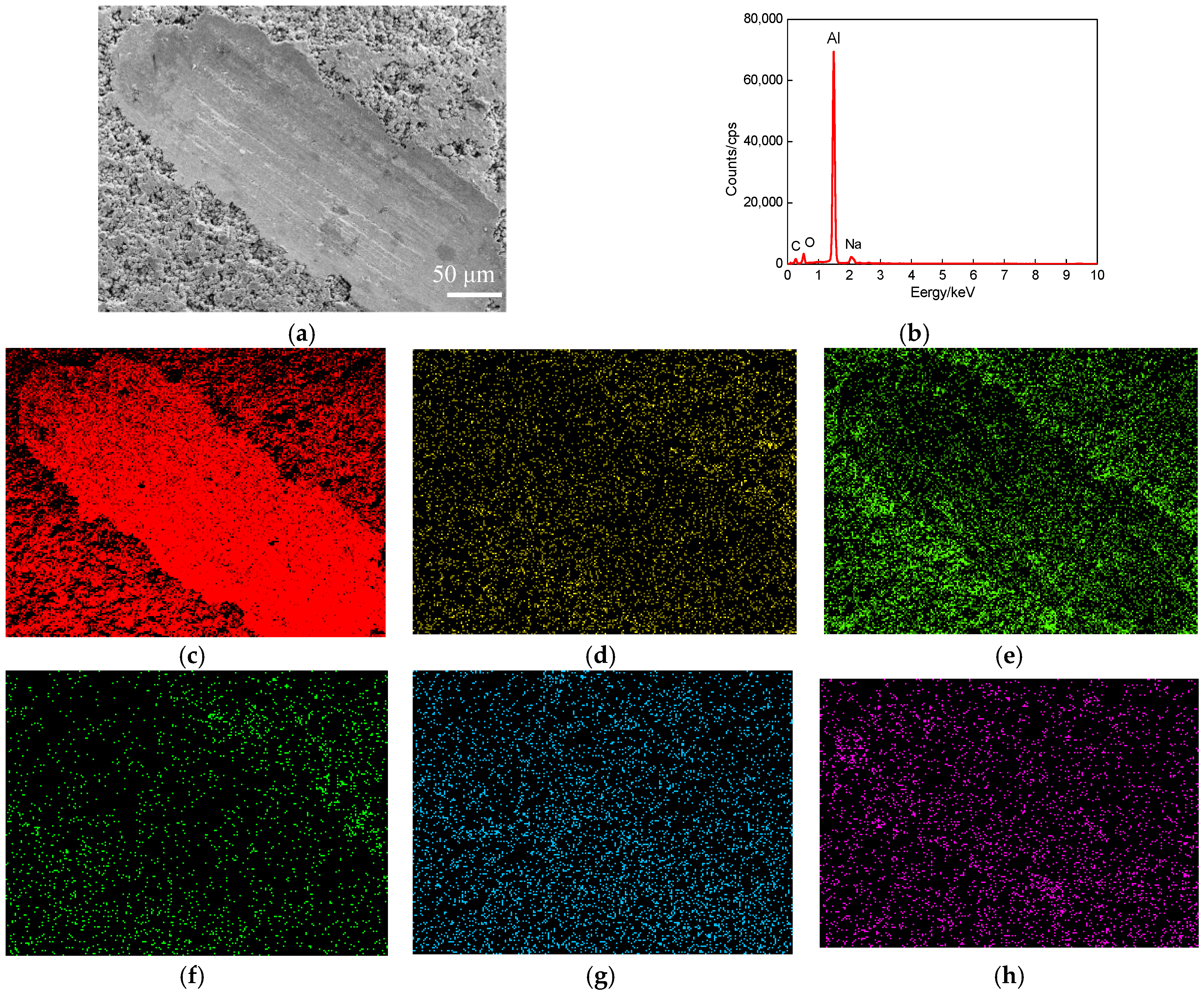
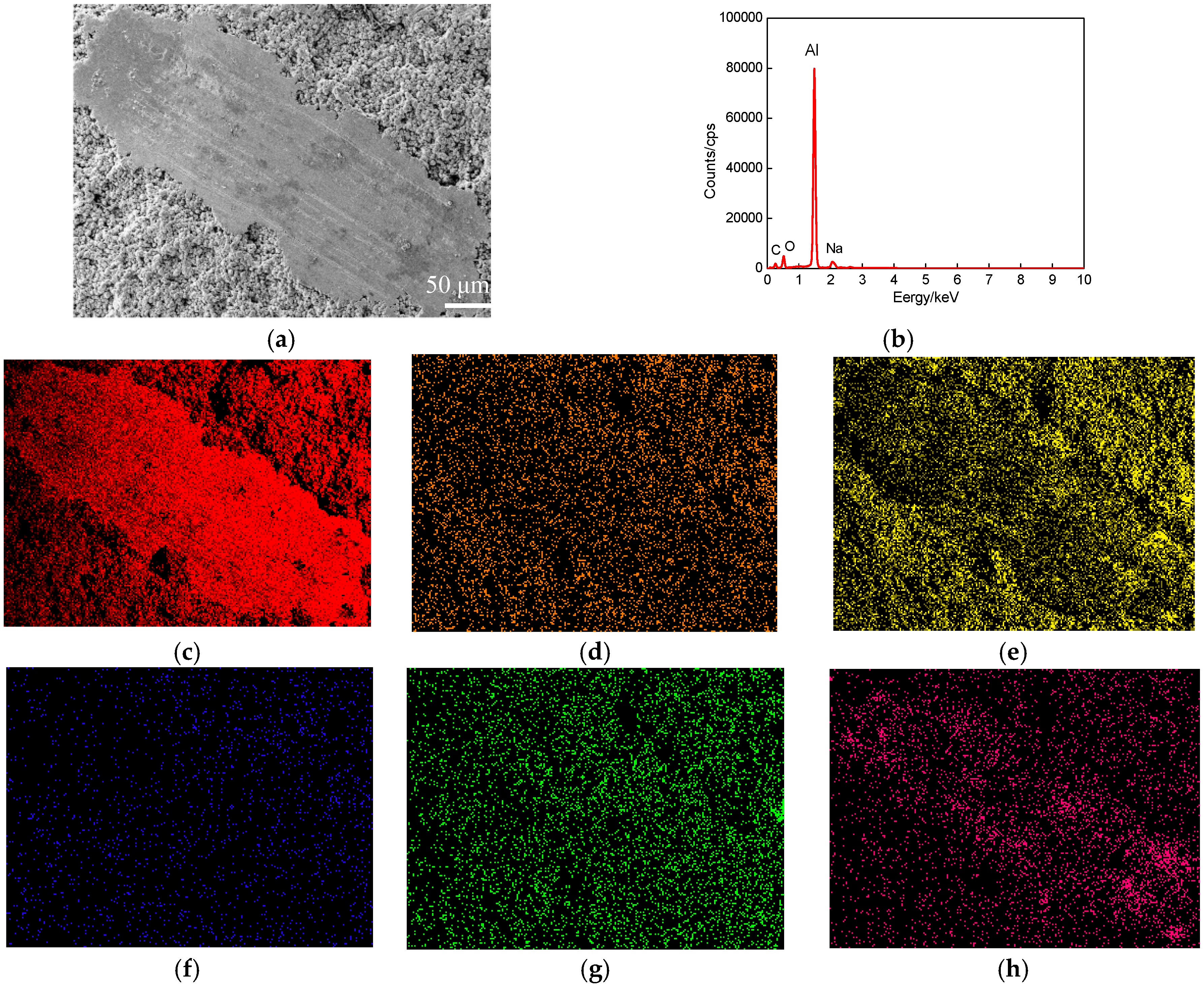


| Item | Value |
|---|---|
| Spray distance/mm | 250 |
| Spot diameter/mm | 5 |
| laser power/W | 800 |
| Speed of argon gas/L/min | 8 |
| Status | Value/HV | Average Value/HV | ||||
|---|---|---|---|---|---|---|
| Before LR | 47.2 | 49.3 | 52.3 | 47.7 | 53.3 | 49.96 |
| After LR | 101.4 | 104.6 | 100.5 | 106.2 | 110.6 | 104.66 |
© 2018 by the authors. Licensee MDPI, Basel, Switzerland. This article is an open access article distributed under the terms and conditions of the Creative Commons Attribution (CC BY) license (http://creativecommons.org/licenses/by/4.0/).
Share and Cite
Jing, Z.; Dejun, K. Effect of Laser Remelting on Friction-Wear Behaviors of Cold Sprayed Al Coatings in 3.5% NaCl Solution. Materials 2018, 11, 283. https://doi.org/10.3390/ma11020283
Jing Z, Dejun K. Effect of Laser Remelting on Friction-Wear Behaviors of Cold Sprayed Al Coatings in 3.5% NaCl Solution. Materials. 2018; 11(2):283. https://doi.org/10.3390/ma11020283
Chicago/Turabian StyleJing, Zhang, and Kong Dejun. 2018. "Effect of Laser Remelting on Friction-Wear Behaviors of Cold Sprayed Al Coatings in 3.5% NaCl Solution" Materials 11, no. 2: 283. https://doi.org/10.3390/ma11020283




